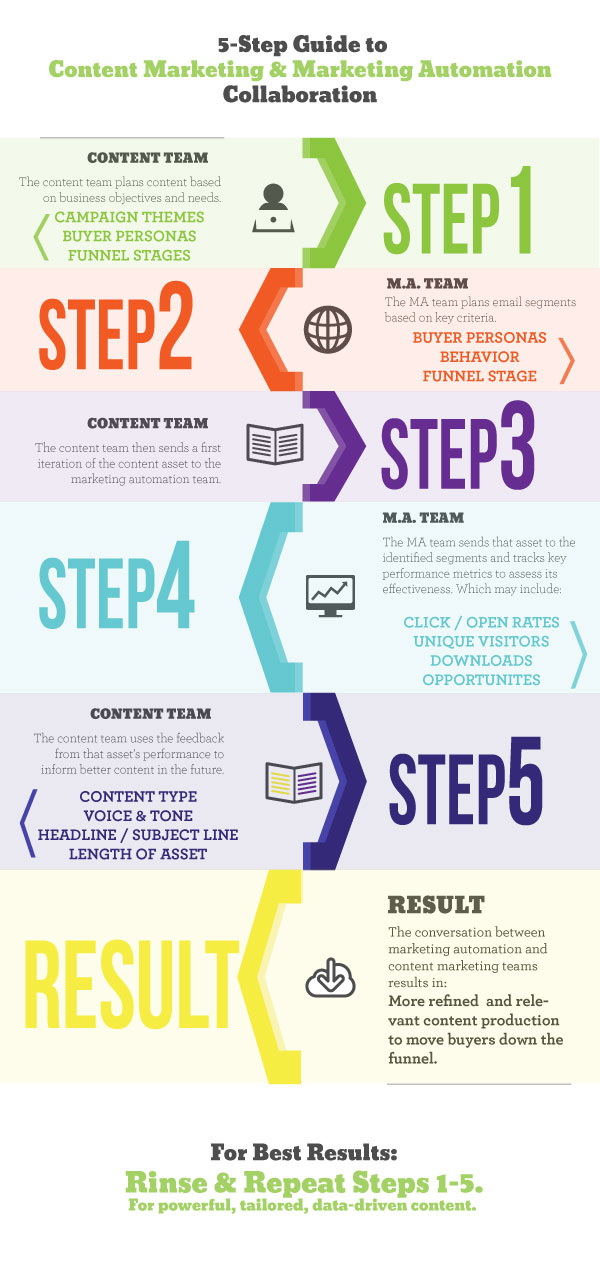
Data is beautiful—especially when it leads to better business, more revenue, and stronger marketing campaigns.
But important insights from data aren’t always communicated between marketers (despite the fact that marketing automation analytics can dramatically inform content marketing production and distribution).
That’s why we’ve created a simple 5-step guide for creating better content based on your marketing automation analytics.
It maps out the back-and-forth dialogue between your content team and marketing automation team, and outlines both teams’ roles and responsibilities for using data to gain insight into the performance of a content asset.
The Content Team

We start with the content marketing team. The first step is to develop a content marketing strategy or plan. This plan will reflect and bolster core business objectives and needs. (Read the Blueprint to a Modern Marketing Campaign to learn how to do this.)
Planning might seem like “an educated guessing game.” You understand what your business objectives are and who your personas are—but without current data, you’re unsure which types of content (eBooks, whitepapers, blog posts) will resonate with your prospects.
Don’t worry. Build your content plan and fill out an editorial calendar. Over the next few months (or, in the context of this blog post, over the next few steps), you’ll create a process with data smack dab in the middle. These insights are rooted in metrics you can use to refine, polish, and perfect content production.
Let’s use a hypothetical example to walk through the next four steps.
Hypothetical Example
Say, for instance you’re in the business services industry looking to sell online accounting tools to other companies.
- Your target buyers are directors of HR, small business CEOs, and owners of non-profit organizations.
- Your content goal is to communicate with them that accounting doesn’t need to be hard.
- Your business goal is to have more people sign up for accounting-focused services.
Based on this information, your content strategy and assets start to take shape.
The Marketing Automation Team

Meanwhile, the folks in charge of your marketing automation software are also making “best guesses” about who should receive each piece of content.
They have excellent insight, sure. Marketing automation tools and lead scoring provide marketers with an unmatched understanding of leads. By blending contact profiles and online behavioral tracking, marketers can get a fairly good understanding of the leads and prospects in their database, like:
- The kinds of topics a person is interested in
- Which type of content a lead tends to engage with
- Form submittal data, such as title and company name
Based on qualifying metrics, the team can accurately find the “right people” for your company’s products or services. And similarly for content distribution strategies, the marketing automation team can find the “right people” for a particular content asset.
Your marketing automation teams starts parsing through data to pick out the prospects who most likely engage with the content being produced. In this case, identify segments that align with your content goal.
Say, in the business services example, the biggest pool of people in your database are small business CEOs. You decide to target them with this content campaign. The marketing automation team communicates this to the content team, so they’re on the same page and targeting the same audience. The marketing automation team starts to build out segments based on these titles and company size.
The Content Team

Back to the content team.
At this stage, the content team starts producing content. As mentioned in step 1, your goal is to connect with small business CEOs to let them know that accounting doesn’t have to be hard, and eventually have them buy your service. In step 2, the marketing automation team confirms the target audience for this campaign.
Now your designers get creative, and decides to create an eBook that unpacks the mysteries behind some of the most complicated accounting topics, like: payroll, accounts receivable, and tracking inventory.
Your CMO loves it. He brings beers to the content team for creating such a cool asset….but…
The Marketing Automation Team

…you can’t really see if that eBook is really driving business, until it’s put to use.
That’s where your marketing automation team comes back in.
They are essentially responsible for the promotion and distribution of targeted messaging, and tracking the performance of your marketing machine. They monitor activities such as contact management, list segmentation, lead scoring and nurturing, A/B testing of website pages and offers, email marketing, and performance measurement and reporting.
But when it comes to content marketing collaboration, the marketing automation team tracks and monitors the success rate of content produced. In this case, the key performance metrics to track for each content campaign or asset could include:
- Email click-through and open rates
- Downloads
- Opportunities generated
- Unsubscribe rates
Tracking this data provides two kinds of insights.
- First, it increases lead scoring data for each prospect on your list. Who opened the email? Who didn’t? Does this say something about their interests or pain points as a buyer?
- Secondly, is provides valuable feedback to your content team. Was the content type, tone, or voice targeted effectively to that buyer? Did the buyer engage with this content?
Over time, businesses tracking performance metrics develop data sets strong enough to discover key insights across users, content creation performance, and what’s working.
The Content Team

And here’s the part where—in most cases—communication falls apart. The marketing automation team must communicate these metrics to your content team. It can’t be said more simply, but this is a challenge for many marketers. It’s key to share with the content team the performance of the various pieces of content they’ve been producing, because this is how they track their success and what drives them to improve. From these data points, the content team can glean valuable production insights.
For example, say that accounting eBook for small businesses flopped.
Email open rates, click-throughs, and leads generated were well below average for your company. When comparing content produced over time, you notice that eBooks typically engage small business CEOs less frequently than other forms of content, whereas how-to videos and short guides drive the most engagement for that segment.
From this, your content team can adjust and improve. Consider key ways in which you can improve your content:
- Content type
- Voice and tone
- Headline (length and semantics)
- Subject line of email (length and personalization)
- Length of asset
- Asset topic
- Time of distribution
For each of these sections ask yourself: What is working? What is not working? And where can we improve?
But no matter the insight, the result is the same….
The Result, Finally.

Your content becomes more refined, more relevant, and more impactful for your target audience and buyers—in the next go around.
Use the data to make stronger content that aligns with what matters to and engages your audience. This is not only good for your buyers, but great for your company.

